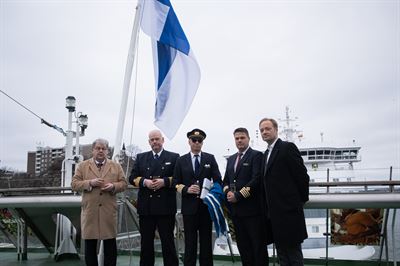Finnish flag hoisted at the stern of Viking Cinderella – all of Viking Line’s vessels are now registered in the Finnish Ship Registry

Viking Cinderella will launch service on the Helsinki–Stockholm route on March 8, revamped and reflagged under the Finnish flag. At the same time, Viking Line will offer daily service again between the two Nordic capitals and expand its cargo capacity significantly. “Every vessel that starts to sail under the Finnish flag enhances the competitiveness of Finland’s maritime transport industry, boosts employment in the country and strengthens national security of supply,” says Tiina Tuurnala, CEO of the Finnish Shipowners’ Association.
To the strains of the Finnish national anthem, Viking Cinderella was transferred to the Finnish Ship Registry in a formal ceremony in Stadsgård port in Stockholm on Tuesday, March 5. With the reflagging, all five Viking Line vessels now sail under the Finnish flag and are subject to Finnish collective bargaining agreements.
“Even before this, we were Finland’s biggest employer in maritime transport, and the reflagging of Cinderella further strengthens our position. We now directly employ about 2,200 people in Finland both on board our vessels and on land, and we also have an economic impact in different places around the country, in part through our sourcing of supplies and investments. Promoting domestic interests is important to us, and the fact that our entire fleet sails under the Finnish flag is concrete evidence of this,” says Jan Hanses, Viking Line’s CEO.
Last year, Viking Line transferred Viking XPRS from Estonia’s ship registry to Finland’s. Viking XPRS sails between Helsinki and Tallinn.
“Every vessel that starts to sail under the Finnish flag enhances the competitiveness of Finland’s maritime transport industry, boosts employment in the country and strengthens national security of supply,” says Tiina Tuurnala, CE of the Finnish Shipowners’’ Association.
According to Finnish Customs statistics, more than 95 per cent of Finland’s international trade is transported by sea, and that share has increased given the extraordinary developments in recent years. Passenger/car ferries and ropax ferries play an important role in maritime cargo transport since they transport most breakbulk cargo (goods shipped in pieces, not in containers) such as food, pharmaceuticals and spare parts for manufacturing.
“It is extremely important today to commit to maintaining continuity in Finland’s goods transport. In international transport, a total of 110 vessels sail under the Finnish flag, and that number has remained pretty much unchanged over the past few years. In order for us to have Finnish maritime transport and Finnish vessels in the future as well, we must ensure that Finland’s flag is competitive with the other EU flags,” notes Tiina Tuurnala.
Viking Cinderella will launch service on the Helsinki–Stockholm route on March 8, and as a result Viking Line will once again provide daily transport between the two Nordic capitals. With the reflagging and new route, most of Viking Cinderella’s crew of 300 Swedes is being replaced by Finns. Some of the vessel’s previous employees are being shifted to the vessel Birka Gotland, in which Viking Line has a 50 per cent holding.
In January, Viking Cinderella spent 18 days at the shipyard in Naantali, where the cabins and other spaces underwent an extensive makeover and the technology on board was updated so that the vessel produces even fewer emissions than previously. At most, Viking Cinderella will be in Stadsgård port for three days, when the vessel’s crew – which is comprised of more than 45 different occupational categories – will undergo safety training, conduct safety exercises and start up service on the new route. Meanwhile, the vessel will undergo regulatory controls in conjunction with the reflagging.
“Changing over to a new route is always a big change, and we want to be sure that our service works the way it should from the very start and that our focus on domestic interests is visible in other ways besides flying Finland’s blue-and-white flag at the stern. Among other things, all signs and other materials such as menus will also be available in Finnish – over the past twenty years, Cinderella mainly served Swedish customers under a Swedish flag,” says Krista Öhman-Jalonen, intendant on the vessel.
Viking Cinderella’s history in brief
- Cinderella was built in 1989 at the Perno Shipyard in Turku, Finland. During its first few years, it was the largest car ferry in the world and Viking Line’s flagship. Cinderella is one of a kind – no sister ship was ever built.
- Cinderella mostly served the Helsinki–Stockholm route from 1989 to 2003 but also made 20-hour cruises between Helsinki and Tallinn.
- In 2003, Cinderella was reflagged under a Swedish flag and changed its name to Viking Cinderella since the name Cinderella was already included in the Swedish Register of Shipping. The then-red sides of the vessel were painted white, in contrast to other Viking Line vessels.
- Since 2003, Viking Cinderella has mostly made cruises between Stockholm and Mariehamn. For several summers, the vessels sailed on the Helsinki–Stockholm route, including in tandem with Viking Gabriella, and also made day cruises to Tallinn.
- On March 5, 2024, Viking Cinderella was reflagged to the Finnish flag and will return to the Helsinki–Stockholm route on March 8 to serve in tandem with Gabriella.
Technical information about Viking Cinderella
- Length: 191 metres, width 29 metres
- Decks: 12
- Cabins: 2,500
- Passenger capacity: 2,560
- Car capacity: 480 passenger cars
